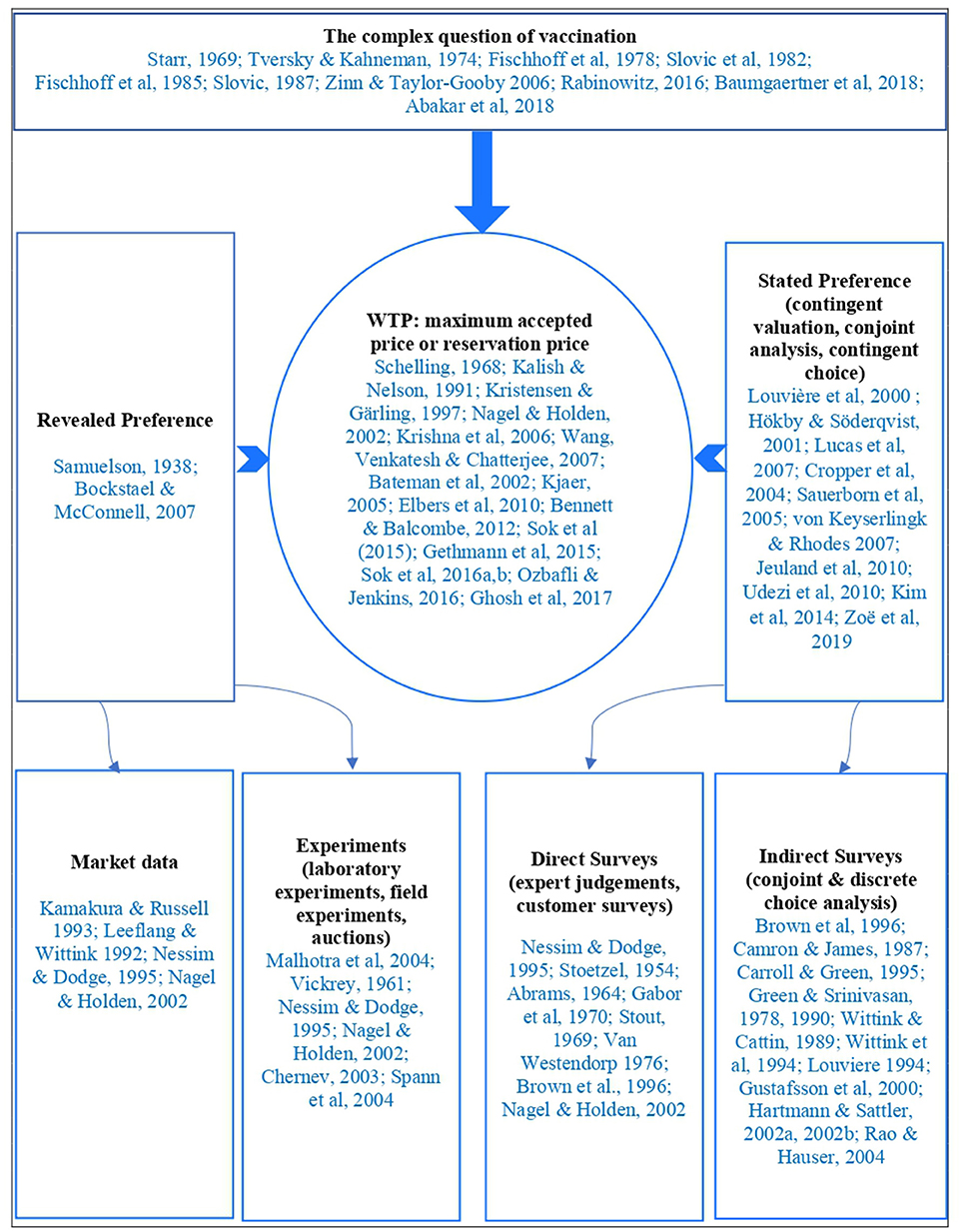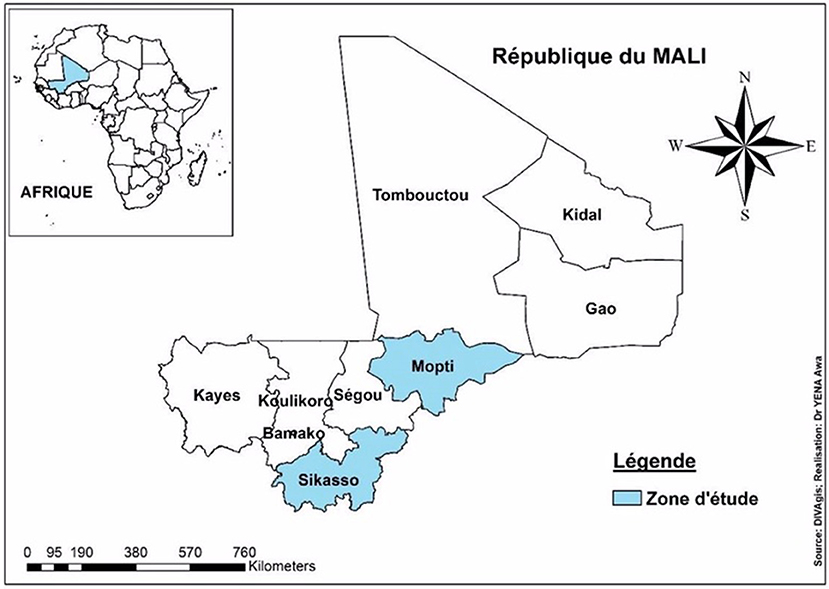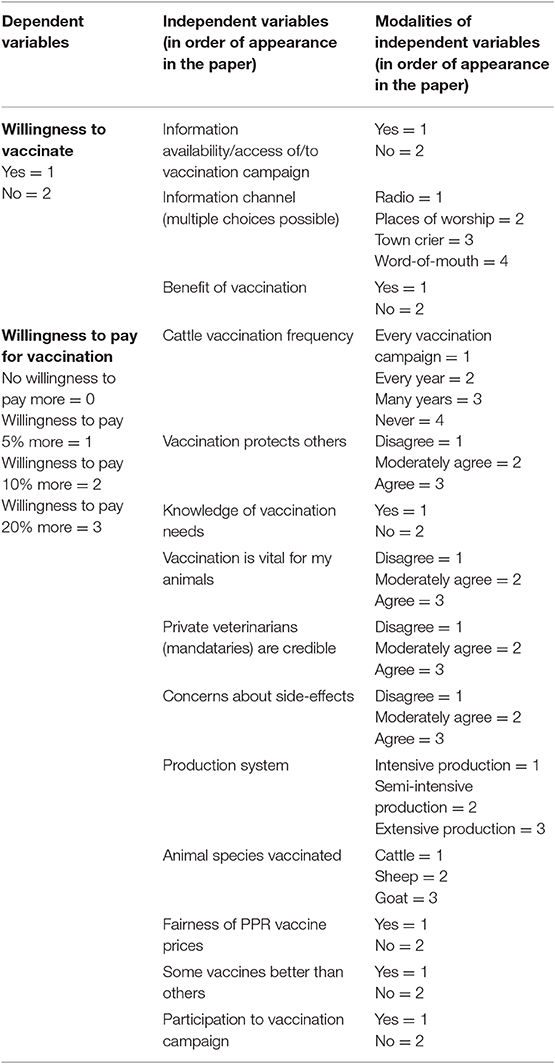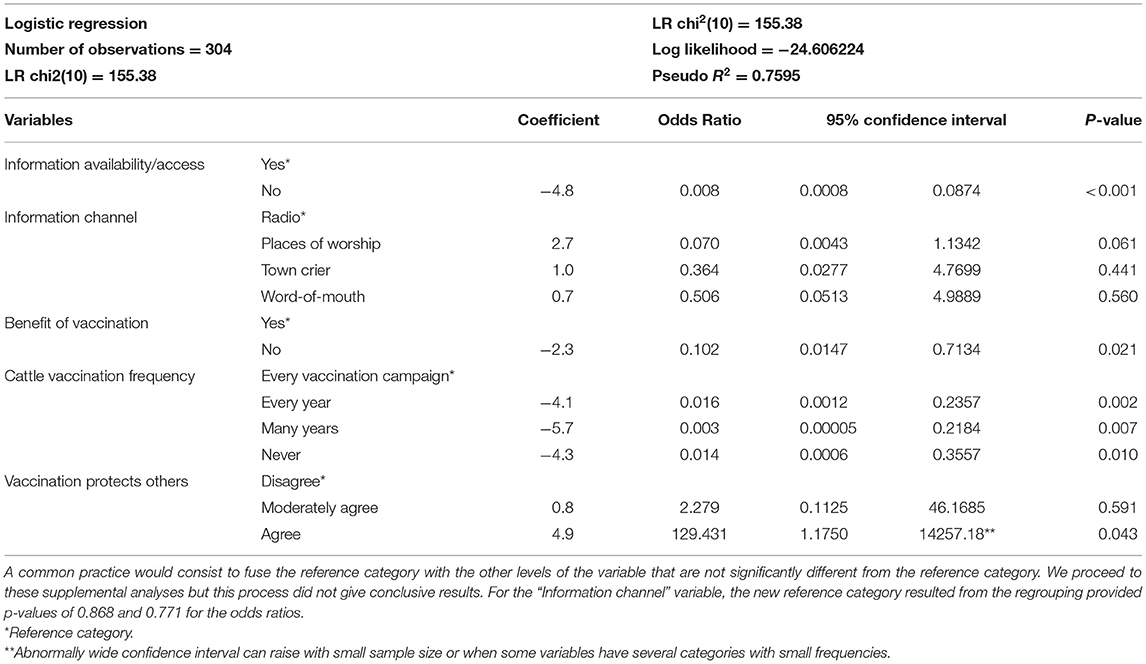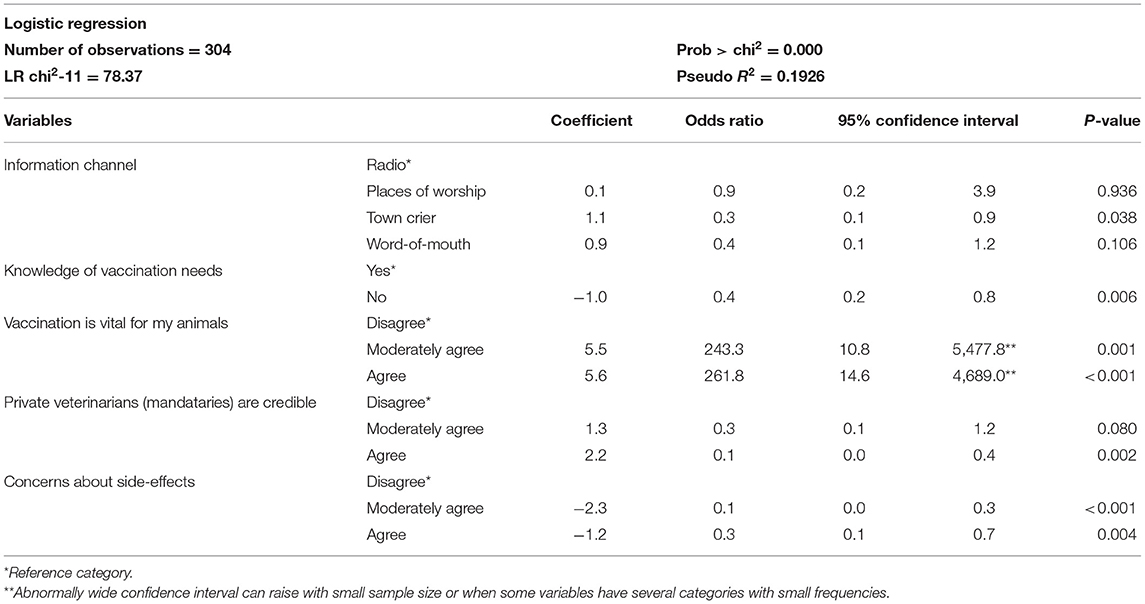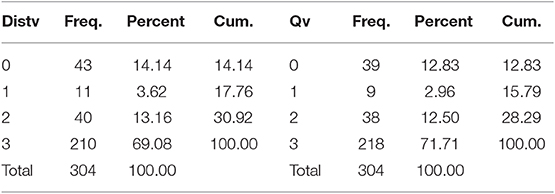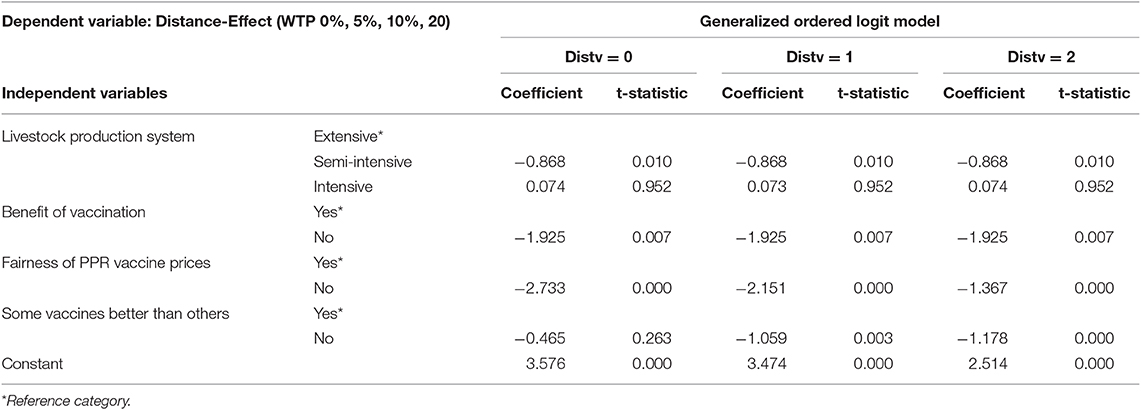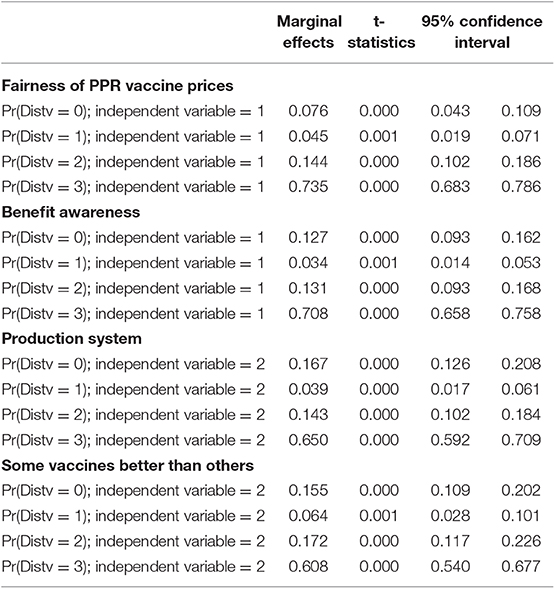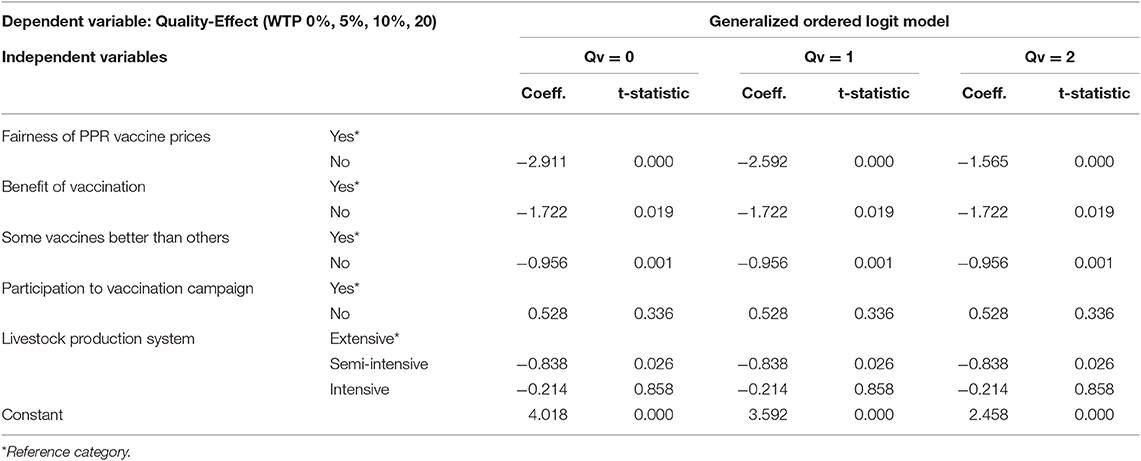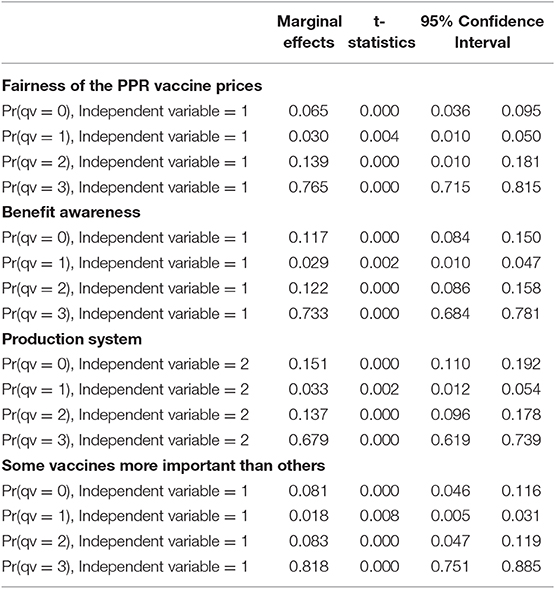Willingness to Vaccinate (WTV) and Willingness to Pay (WTP) for Vaccination Against Peste des Petits Ruminants (PPR) in Mali
- 1International Livestock Research Institute, Nairobi, Kenya
- 2Centre de Coopération Internationale en Recherche Agronomique pour le Développement (CIRAD), Montpellier, France
PPR remains a major challenge to smallholder farmers in Mali. To understand the drivers of low adoption of vaccination by farmers, we analyzed the socio-economic factors influencing farmer WTV during and in the absence of vaccination campaigns. Given that the costs associated with vaccination are largely borne by farmers, we assessed factors that associated with farmer willingness to pay (WTP) more than the current price (150 XOF per dose) by considering two attributes of improvement of the vaccines empirically highlighted as potential leverage points for intervention: access of farmers to vaccines (reducing the distance to the vaccine) and availability of information about the quality of the vaccine (introducing a vaccine viability detector). Data were collected in Mopti and Sikasso regions from 304 producers. Overall (n = 304), 89 percent of respondents vaccinated their herds during official vaccination campaigns. They are associated with receiving information on the campaign calendar more quickly if information is relayed at places of worship and if they have an awareness of the benefits of vaccination, including the protection of third parties. Only 39 percent of respondents vaccinate outside vaccination campaigns. They are positively linked to the credibility of private veterinarians and a recognition of the vital importance of vaccines but are negatively associated with ignorance of vaccination needs and concern about vaccine side-effects. Both distance-effects and quality-tracker effects are associated with farmer willingness to pay more than the current vaccine prices. Farmers practicing semi-intensive production systems are willing to pay 20 percent more than the current vaccine prices, as are users who believe in the beneficial effects of vaccination, users who consider the prices of vaccines as fair, and those who believe that some vaccines are more important than others. Factors that discourage producers from vaccinating or from paying more for vaccination would be more effectively managed with better communication on vaccine benefits through targeted information dissemination campaigns by Malian authorities. Greater price transparency throughout the vaccine production and deployment chain is critical, while timely availability of vaccine tested for viability would increase the willingness to vaccinate while improving access.
Introduction and background
Livestock plays a critical role in Mali's economy. It represents 25% of the GDP of the primary sector and 11% of the national GDP. Livestock farming is the main source of income for over 30% of the population (1). At least 85% of rural households own domestic ruminants, with small ruminants (SR) representing a significant part of the livestock sector having ~40 million heads in 2016 (2). SR keeping provides readily available cash in the face of family needs, a source of livelihoods, medium-term assets, protein for daily meals, and socio-cultural functions. However, the multifunctional role of SR is threatened by the high burden of diseases, such as Peste des Petits Ruminants (PPR).
The principal method of control for PPR is vaccination which is reflected in the Global Control and Eradication Strategy for PPR1. There are many vaccines that are commercially available and have shown to be effective for at least 3 years post-vaccination (3, 4). However, most of them require the application of a strict cold chain during their deployment in the field. It is important that all SR are vaccinated because introduction of unvaccinated animals into a naïve population presents a high risk. Thus, the PPR Global Control and Eradication Strategy recommends at least 80% of vaccination coverage for SR above 3 months old (5).
Despite heavy investment of the public veterinary services of Mali in vaccination campaigns against PPR, countrywide vaccination coverage for SR is very low at just 7% (6). Nonetheless, demand exists for PPR vaccines, especially where innovative delivery mechanisms can be deployed. For instance, reports from ongoing development projects showed that up to 55% vaccination coverage in specific communes of the regions of Sikasso and Mopti (7) is possible using participatory approaches through Innovation Platforms to increase stakeholder participation in vaccination. However, there are many challenges encountered by stakeholders in the process of vaccination in Mali. First, private veterinarians still complain of unfair competition from State veterinarians in properly carrying out vaccination. Furthermore, vaccine delivery systems are often not very effective in reaching all SR livestock producers, particularly women, due to logistical problems caused by poor infrastructure, such as roads to reach remote villages and the absence of vaccination parks for SR. In addition, the cost of vaccination in Mali is largely borne by livestock farmers, constituting a barrier to participation given that not all livestock producers can afford it and some livestock producers do not feel there is enough benefit from investing in vaccination. Some stakeholders argue that the limited participation of livestock farmers in vaccination is not caused by the perceived high cost of vaccination, but rather poor access to good quality vaccines, together with a lack of awareness about timing of vaccination campaigns (6, 8). The maintenance of the cold chain throughout the vaccine delivery might also be a constraint.
The objective of this study was to assess farmer perceptions about vaccination of SR livestock, with particular emphasis on their willingness to vaccinate (WTV) and willingness to pay for vaccination (WTP). For the WTP, as already highlighted by Dione et al. (9) and Sadio (8), we considered the delivery of the vaccines at the closest area of residency (termed “distance-effect”) to facilitate accessibility and improved information on the quality of the vaccine (termed “quality tracker-effect” by introducing a vaccine viability detector2).
Materials and Methods
Literature Review and Theoretical Framework
Decisions for vaccination, whether human or livestock, can often be more associated with religious and spiritual reasons, personal opinions, safety worries and additional information, beyond any knowledge of risks, costs, and benefits (10, 11).
Through a qualitative study, Abakar et al. (11) identified a number of demand-side barriers to vaccination, including mistrust of vaccination programmes/services and health system issues, among mobile pastoralists in Chad. Given the singular relationships of Sub-Saharan pastoralists to their herds (12), it seems reasonable that vaccination hesitancy and refusal might be an issue for immunization operations against animal diseases. Once the decision to vaccinate is taken, and given vaccination is not free in Mali, it would be important to better understand the root causes or drivers of individual decisions to pay for vaccination services.
One approach to gaining such understanding is through the concept of willingness to pay, which is defined as the maximum price a consumer accepts to pay for a product or a service (13–16).
There are two main ways to measure the willingness to pay. The first approach, based on revealed preference and pioneered by Samuelson (17), holds that consumer preferences can be expressed through what they purchase under different incomes and prices. This perspective represents evidence-based choices from market data and various types of experiments (laboratory and field experiments or auctions). The second approach is based on stated preference which tries to determine the total economic value by incorporating both non-use value and option value through contingent valuation, conjoint analysis or contingent choice methods. Derived from direct and indirect surveys, the stated preference approach has been popularized by studies of the willingness to vaccinate or to pay for vaccines against human diseases (18–24) and recently against animal diseases (25).
With regard to animal diseases, there is limited evidence describing the decision-making behind the vaccination of livestock. Elbers et al. (26) highlighted economic and social-psychological factors behind farmers' motivations to participate in a voluntary vaccination programme as well as their perceived need to actively be a part of the eradication campaign. Sok et al. (27–29) and Gethmann et al. (30) discussed the motivations, barriers, and willingness to vaccinate against bluetongue disease, while Bennett and Balcombe (31) investigated farmers' willingness to pay for a bovine tuberculosis (bTB) vaccine. These studies, however, focused on animal diseases in Europe. Their findings may be different to the situation of West African countries where vaccine coverage is low, health delivery systems insufficiently meet current needs, and effective communication approaches and tools are lacking (Figure 1).
Methodology and Data
Objectives
Our overall objective is to assess the willingness of Malian livestock farmers to vaccinate (WTV) and their willingness to pay (WTP) for improved attributes of vaccines against PPR for SR. Two contingent concepts were analyzed separately, as some factors may affect WTV but not WTP for various reasons, such as farmer belief about the unfairness of vaccine pricing mechanisms. Therefore, we address two main questions:
i. For the WTV model: What are the socio-economic determinants of the attitude of livestock farmers regarding vaccination against PPR, i.e., in terms of choosing to vaccinate or not?
ii. For the WTP model: What are the socio-economic determinants associated with the farmer willingness to pay more than the current price for improved accessibility to the PPR vaccine (distance-effect) and quality of the vaccine (quality-tracker effect)?3
Survey Tool
A questionnaire (see Appendix) was designed to collect data on household demographic characteristics, Production systems, vaccination knowledge and practices, constraints of livestock producers to vaccination and farmer WTV and WTP for vaccination, considering vaccine accessibility and quality.
Sample Size
For our study, a sample was drawn from 4,254 producers who were identified as Feed the Future—Mali Livestock Technology Scaling (FTF-MLTS) program beneficiaries. We initially agreed to work with a margin of error of 3–5%, a confidence interval of 95% and a proportion of 50%. This involved selecting a sample size between 352 and 1,265 producers. Finally, due to access issues mainly related to insecurity4 and limited budget, 304 livestock farmers keeping either SR only or SR and cattle were reached. Among these livestock producers, 50% were from Mopti and 50% from Sikasso region (Map 1).
Data Collection and Processing
The survey tool was designed on ODK (Open Data Kit) and transferred to Samsung tablets for electronic capture. In each region, trained field veterinarians and veterinary technicians were recruited to administer the questionnaire to livestock producers. The team leader of the field activities oversaw data cleaning and quality assurance every day after the enumerators returned from the field. Data was then uploaded to the server and downloaded in Excel and statistical files for further cleaning and analysis.
The data were processed in several ways:
– For willingness to vaccinate (WTV): Two binary variables were identified and used: (1) participation in vaccination campaigns and (2) use of vaccination outside of vaccination campaigns. To avoid overloading the analysis with a large number of variables, a correlation analysis was carried out to discriminate variables that have strong correlation with the identified binary variables.
– For willingness to pay (WTP): Questions about WTP generated multiple responses which we considered as polychotomous dependent variables, requiring the use of a multinomial logistic regression.
Correlation and multicollinearity analysis allowed the identification of about fifteen independent variables for the estimation of WTV and WTP. Detailed explanations of the variables used in the regression analyses (described next) are presented in Table 1.
Regression Analyses
We used a generic binary logistic regression analysis to better capture the socioeconomic factors that are associated with WTV and a multinomial logistic regression (Gologit model) to analyze WTP.
Binary logistic regression reflects situations in which the observed outcome for a dependent variable can have only two possible categories. Our study on WTV deals with “To vaccinate” vs. “Not to vaccinate.” For the multinomial logistic regression approach, its use represents situations in which the outcome can have three or more possible ordered or ranked responses. Our study on WTP involves multiple responses, such as “Not willing to pay a supplement,” or “Willing to pay a supplement of 5%,” “Willing to pay a supplement of 10%,” or “Willing to pay a supplement of 20%” for potential improvements in access to a vaccine and information on the quality of the vaccine.
We can generalize the Gologit model used in this paper by generalizing the bivariate logit model and considering an ordered dependent variable taking j modalities, written as:
where x1…xk are the regressors that influence y*, is latent, and ei is the error term. As in the binomial case, the y* modalities would depend directly on the position of y* with respect to different threshold parameters or cutoffs that demarcate the boundaries of the various categories:
By defining F as the function for distributing error terms that follows a logistic law, we have:
The model coefficients θ are estimated by maximum likelihood. In addition, it is essential to understand and test an implicit hypothesis of this model, known as the parallel regression hypothesis, for the ordered logit model, and the odds proportion hypothesis (32–34).
Equations (2–4) can be used to derive the cumulative probabilities that are written in the simplified form by: .
These last equations show that the ordered regression model is equivalent to J − 1 binary regressions under the fundamental assumption that estimated coefficients with respect to the explanatory variables are identical in each of the equations.
In contrast to binary models, interpreting the coefficients of an ordered model is complicated, especially for intermediate modalities. To do so, we calculate the marginal effects of variables on the probabilities (as in Equations 5–7) and resort to the transformation of coefficients into odds ratios or conditional probabilities.
There are two ways to determine the overall marginal effects on the sample: evaluate at mean data value or evaluate for each observation and calculate the average of the individual marginal effects in the sample. For large samples, both methods give similar results. For our paper, we chose to calculate the marginal effects in relation to the median individual.
When outcome variables are ordinal, the ordinal logit model has been popularly used. However, some researchers, such as Williams (33, 34) prefer to use the Generalized ordered logit/partial proportional odds models (Gologit/ppo) as they provide more robust results even if the interpretation of model outcomes becomes more difficult. Therefore, Williams (33, 34) writes the Gologit model as:
where M is the number of categories of the ordinal dependent variable.
Finally, the probabilities that Y will take on each of the values 1, 2, …, M can be determinated by:
Depending on the values of M, it would be possible to have an equivalent of a logistic regression model (M = 2), or a series of binary logistic regressions (M > 2).
Context and Study Area
Livestock vaccination is run through public-private partnership. It is mainly carried out by established private veterinarians called “mandataires” (or mandataries) under the supervision of the public veterinary services except in areas where these public veterinary services are not established. In high insecurity regions, vaccination is provided free of charge by the government or some development organizations. In contrast, private veterinarians fully recover the cost of vaccination from farmers. Every year, official vaccination campaigns for livestock are launched by the Government in early October and will last to March. However, given random sources of funding and mobility of livestock keepers, farmers who miss this vaccination campaigns can get their animals vaccinated by available veterinarians in their communities at any time of the year; this is referred to as “outside vaccination campaigns.”
The FTF-MLTS program seeks to contribute to the inclusive growth of the ruminant livestock value chains for increased income, food and nutrition security for 266,000 cattle, sheep, and goat keepers and other value chains actors in three regions in the country (Mopti, Timbuktu and Sikasso), as a means of lifting them out of poverty. Supported by the United States Agency for International Development (USAID) as part of the US government's Feed the Future initiative, the program sets out to bridge ruminant livestock productivity gaps and to enhance the volume and value of ruminant livestock marketed through a wide-scale dissemination of proven livestock technologies and best practices. The FTF-MLTS program has made priority investments in designing and rolling out innovative approaches to increase vaccination coverage of SR and cattle against PPR and Contagious Bovine Pleuro-Pneumonia (CBPP), respectively and bovine/ovine pasteurellosis (7).
Results
Contingent valuation methods for eliciting preferences for non-marketed goods are useful in addressing actor WTP. In this survey, we first asked farmers if they are willing to pay 20% more than the current PPR vaccine price, then 10% more and finally 5% more if the health services were delivered at the closest area of residency (distance-effect) to facilitate accessibility. The same questions were asked for improved information about the quality of the vaccine (quality-tracker effect).
Almost all livestock producers (96%) perceive tangible benefits of vaccines for herd size, as they expect fewer animal losses. However, while 44% of them are not aware that vaccinating their herds can also protect those of others, 29% thought that vaccination is required only during outbreaks, and 24% believed that vaccination serves to fatten animals.
Regression Analysis Results for the Willingness to Vaccinate (WTV)
Almost 89% of the 304 respondents vaccinate their herds during the vaccination campaigns formally organized by public authorities while 11% of them did not vaccinate. Outside formal vaccination campaigns, only 39% of respondents vaccinate their herds while 61% stated that they did not vaccinate outside the period of organized campaigns (Table 2).
Factors Associated With the WTV During Vaccination Campaigns
WTV during vaccination campaigns was found to be significantly associated with the availability, access and attributes of information provided about the vaccination campaigns (Table 3).
Given the prominent place of religions in Mali, places of worship play an important role for information sharing. Through them, information on vaccination campaigns is more effective in incentivizing actors to vaccinate their animals. Previous experiences with cattle vaccination could, however, constraint the care of small ruminants as this factor is negatively associated with the WTV. For an equivalent price per dose of vaccine, there seems to be a trade-off between the different species to protect. The respective odds ratio of each of these attributes, however, is relatively small, implying a limited effect on the probability of participating in vaccination campaigns.
In Malian rural areas, scrutiny and judgment of community members are important social values that reinforce peer effects. Recognition that vaccinating can help to protect herds other than those owned by themselves constitutes an important incentive for vaccination. With regard to the potential impacts on third parties, the farmers who agree that vaccination protects their herds have a WTV that is 129.4 times more often than the farmers who disagree.
Factors Associated With the WTV Outside Vaccination Campaigns
Even though only 39% of respondents claim to vaccinate their flocks outside of official vaccination campaigns, we observe that lack of knowledge about vaccination needs (different from vaccination benefits) and concerns about side-effects discourage actors from vaccinating (Table 4). This may be due to the presence of less experienced or non-trained technicians handling vaccination outside of official campaigns, leading to a greater incidence of side effects due to poor vaccination techniques. On the other hand, the credibility of private veterinarians (referred to as the variable “Mandataries are credible”) and the recognition of the vital importance of the vaccines were all shown to have a positive effect on their WTV. The strong odds ratios indicate that farmers who moderately and fully agree that vaccination is vital have a WTV that is 243 to 262 time higher compared to farmers who disagree (Table 4).
Regression Analysis Results for Willingness to Pay (WTP) for Vaccination
We recoded the variables and created new ones to allow their use in an ordered logit regression: Distv and Qv were the variables measuring the willingness to pay a premium for vaccine delivery to be significantly shortened and for a quality-tracker to be implemented on the vaccine packages, respectively. Their modalities are: “1” if the farmer is willing to pay 5% more on the current price of the vaccine; “2” if he/she is willing to pay 10% more; “3” if he/she is willing to pay 20% more and “0” if he/she refuses all three options and therefore does not want to pay anything more on the price of the vaccine. From field investigations, a large majority of farmers (69% and 71%) say they are willing to pay 20% more than the current price of the dose of PPR vaccine if, respectively, the delivery distance and quality-tracking of the vaccines are improved (Table 5). It should be noted that between 13 and 14% of farmers say they are not prepared to pay more regardless of the improvement made in the delivery and quality-tracking of vaccines, respectively.
A generalized ordered logit (Gologit) model was used to address shortcomings of the ordered logit model and parallel-lines model as stated by the Brant's test (33, 34), which rejected the parallel regression assumption (Table 6).
Based on the existing literature, our knowledge of the Malian context, and the use of a stepwise approach, the following predictive variables were included:
– For the distance-effect-Distv: “Production system,” “Animal species vaccinated,” “Mandataries are credible,” “Fairness of PPR vaccine prices,” “Benefit awareness,” “Some vaccines better than others,” “Cattle vaccination frequency.”
– For the quality-tracker effect-Qv: “Production system,” “Animal species vaccinated,” “Mandataries are credible,” “Fairness of PPR vaccine prices,” “Benefit awareness,” “Some vaccines better than others,” “Cattle vaccination frequency,” “Vaccination campaign participation.”
Finally, the regression was done successively on the distance-effect (Distv) and the quality-effect (Qv).
For the Distance-Effect: Distv
Table 7 shows that, all other things being equal, farmers in semi-intensive production systems, those who perceive that PPR vaccine prices are fair, that vaccination is beneficial, including the comparative advantage of PPR vaccines, are willing to pay a premium if the physical access of vaccines is improved.
The regression analysis further reveals that the coefficients for “Production system” and “Benefit awareness” do not vary across the categories of the response variable, i.e., the distance-effect. This means “Production system” and “Benefit awareness” have positive impacts on the distance-effect. Therefore, the more the farmers in semi-intensive production system are aware of the benefits of vaccination, the greater their willingness to pay a premium for a shorter vaccine delivery distance.
These trends are visible only through sign and significance at this stage. To improve the quality of interpretation of the regression results (Table 8), we tabulate the marginal effects and coefficients into odds ratios or conditional probabilities.
Farmers declare that they are willing to pay a higher price than the current vaccine price if physical access to it is improved by a significant reduction in the distance of supply and also if other conditions are met. When farmers consider the price of PPR vaccines to be fair, their probability of paying 20% more than the current price of a vaccine dose increases by 73%. When they are well aware of the beneficial effects of vaccination against PPR, the probability increases by 71%. When farmers are in semi-intensive production system, the probability of paying 20% more increases by 65%. When they believe that some vaccines are better than others, the probability increases by 61%.
For the Quality-Tracker Effect: Qv
WTP for improved quality tracking of PPR vaccines is associated with the same significant variables: “Production system,” “Benefit awareness of PPR vaccination,” “Fairness of the PPR vaccine prices,” and “Comparative advantages of some vaccines” (Table 9). When respondents indicate “No” to one or more of these variables, this has a negative impact on WTP for a vaccine-quality tracker. Thus, when a farmer is frustrated about these variables (e.g., feels prices are not fair), it reduces their willingness to pay a premium above the current vaccine prices (Table 9).
If they are convinced that vaccine prices are fair, their probability of paying 20% more on the current price of vaccines increases by 77% (Table 10). In the same way, if they are aware of the benefit of PPR vaccination, the probability for paying the vaccines 20% more is 73% (Table 10). The practice of semi-intensive production activities also leads them to an increase in the probability of paying 20% more to 68% if the quality of vaccines is improved. And finally, the awareness of farmers about the relative comparative advantage of some vaccines increases their probability of paying 20% more for vaccines than their current prices by 82% (Table 10).
Discussion
PPR is a concern for the Malian livestock sector where the vaccination coverage is still very low. Although effective vaccines are available, the disease remains endemic for various reasons. Many of these reasons relate to the willingness of livestock producers to vaccinate or to pay for vaccination. Our study focused on socioeconomic factors influencing the WTV and WTP for vaccines against PPR in Sikasso and Mopti regions in Mali. The study led to interesting findings which highlight a number of important policy implications.
First, the place and function of beliefs in the decision-making process are often neglected, even though they can validly be the result of rational behavior. Vaccination programmes against animal diseases are mostly evaluated by using availability and access to vaccines. Although these two elements are very important, it appears that farmer beliefs associated with their participation in vaccination programmes are crucial to understand their decision-making process to vaccinate or pay for vaccination (26–30). The challenge of considering farmer beliefs and perceptions about vaccination is to better understand their behavior, but also to develop appropriate policy instruments to increase their participation in vaccination campaigns and improve the effectiveness and efficiency of voluntary vaccination strategies (26). Our study places greater emphasis on the behavior of farmers and shows that their decisions are based on their perceptions of the characteristics and effects of vaccination against PPR.
Second, market orientation (semi-intensive production) plays an important role in the willingness to pay for vaccination. The use of fattening operations, while still maintaining some flexibility for animal mobility, suggests a stronger market orientation compared to the extensive system. Vaccination, even when paid for, appears to be a part of this strategy, more than in other production systems.
Third, our results show that making information on vaccination campaigns more accessible and livestock producers more aware of the benefits of vaccines, may change their WTV and WTP. This requires working both on the content and form of information dissemination. The information must go beyond simply informing livestock producers about the dates and periods of vaccination campaigns. Rather, such information needs to effectively communicate the positive role of vaccines in the control of animal diseases; on their protective effects on the herd and those of neighbors; and their potential side effects, whether positive or negative.
Dissemination of information through different media, such as places of worship, communal radio stations, mouth-to-mouth, etc. have proven to be somewhat effective, though future research must accurately assess these platforms in greater depth. All these media require physical access while there are great opportunities to expand information access through innovative ways with the growing accessibility of internet-based web applications and mobile phones in this country.
Fourth, the results highlight the negative impact of livestock farmers' perceptions about inequity of vaccine prices. Our study does not directly show this; however, discussions we had after the study indicate that farmers seem to perceive differentiated (and unfair) vaccine pricing between cattle and SR that does not consider the differences in size and value of each species. This involves trade-off behaviors between vaccinating cattle and small ruminants. They do not seem to be aware of the costs of producing and deploying the vaccines to be considered. Therefore, the Malian authorities might benefit from including greater price transparency throughout the vaccine production and deployment chain by facilitating an equal access to and greater clarity about price information. For instance, enhanced communication about the subsidies supported by Malian authorities could help in this transparency.
Fifth, regarding farmers' trust of private veterinarians, the FTF-MLTS program took an important step to address this lack of trust through better planning of vaccination campaigns using participatory approaches vaccination delivery through Innovation Platforms (IPs). Preliminary results show that IPs have been able to strengthen trust between farmers and private veterinarians, consequently improving performance of vaccination campaigns (9).
Finally, results of our model clearly suggest that distance and quality perceptions are critical issues underpinning farmer willingness to pay for improved vaccines. Developing logistical support and efficient supply chains that improve access to vaccines in a timely manner is critical. Porphyre et al. (35) showed that the initial availability of vaccine stock at the start of an outbreak significantly contributes to optimal control strategies for disease outbreaks. Therefore, development of basic infrastructure and control of the cold chain are critical in the implementation of optimal health delivery systems. This can explain the respondents' desire and WTP for a test that shows them whether a vaccine is viable.
The main limitation of this study is intrinsically linked to the inaccessibility of some areas due to the security problems that have characterized the country for more than a decade. This security situation is even more tense in the livestock areas in particular from Mopti region to the extreme Northern part of the country. Thus, the sampling of households to be surveyed was carried out only in accessible areas, particularly those targeted by the FTF-MLTS program. Based on our survey results, this area's PPR vaccination participation rates (89% during and 39% outside of campaigns), seem relatively high compared to estimates of the country's overall PPR vaccination coverage of 7%. Therefore, our survey sample and results might not reflect all relevant drivers of WTV or WTP for livestock farmers throughout the country.
Another limitation is that dichotomous and polychotomous categorial variables were used with two or more categories or levels. Responses from livestock producers can be too narrow in relation to the question, such that they create or magnify bias that is not factored into the survey. For instance, on the question about satisfaction with vaccines, people might be satisfied with the intrinsic quality of vaccines but upset about the behavior of vaccinators. Combining our approach with a more quantitative approach on the household economics allowing to collect data related to household income, expenditures and budgets might help to refine further the analysis. In addition, a qualitative approach (e.g., open-ended interviews) could also help to clarify some of the producers' responses.
Conclusion
This study focused on livestock farmers' attitudes and behaviors around vaccination, identifying socioeconomic factors that are associated with WTV animals and WTP for vaccination. These factors could be effectively managed by improving information on the benefits of vaccination, confidence in the viability of vaccines upon arrival at producers' herds, the qualifications of private veterinarians in charge of vaccination, vaccine pricing transparency, and improved information sharing about vaccination campaigns.
Data Availability Statement
The datasets generated for this study are available on request to the corresponding author.
Ethics Statement
This study was implemented in the framework of a larger programme that aimed at improving access of livestock producers to veterinary inputs in Mali. All participants to this specific study were already enrolled by the programme to receive interventions for increasing vaccination coverage against PPR in their areas. For the individual interviews, informed oral consents were obtained from all participants. In addition, an official approval was obtained from the National Directorate of Veterinary Services in accordance with their national mandate to carry out post-vaccination sero-monitoring for PPR and evaluate vaccination campaigns in the target regions (approval reference number N0057/MEP-DNSV).
Author Contributions
All authors listed have made a substantial contribution to the work and approved for publication. MD, AW, AF, and BW conceived the study. AW, MD, and AY supervised the data collection and performed the preliminary data analysis. MD, BW, and AF developed and implemented the PPR control in Mali. AW and KR supervised and performed the economic analysis on WTV and WTP.
Funding
This work has been funded by the USAID—Feed the Future—Mali Livestock Technology Scaling (FtF-MLSTP) program. We also acknowledge funding of the CGIAR Research Program (CRP) on Livestock and all donors and organizations which globally support its work through their contributions to the CGIAR Trust Fund.
Conflict of Interest
The authors declare that the research was conducted in the absence of any commercial or financial relationships that could be construed as a potential conflict of interest.
Footnotes
1. ^http://www.fao.org/emergencies/resources/documents/resources-detail/en/c/282777/
2. ^Producers sometimes have a little trouble judging the quality of a vaccine. Some still use observations (such as the texture of the product) to get an idea of the quality and decide whether or not to vaccinate. Having a detector that can immediately show whether the vaccine is good or not could greatly help.
3. ^Intuitively, it is worth bearing in mind that attributes that are to be focused on in the WTP work would come from the WTV analysis that precedes it. In this study, even though WTV is a sine qua non condition of WTP, we opted to test two key criteria related to access to vaccines and the true or false perception of the quality of vaccines.
4. ^Mali is facing increased security threats and a protracted political crisis. This raises the security-risk level across the country and constraints interview-based fieldwork.
References
1. FAO. Mali Livestock Sector Brief . Livestock Information, Sector Analysis Branch, AGAL, Rome (2005).
2. DNPIA. Direction Nationale des Productions et des Industries Animales (DNPIA). Rapports Annuels 2016. Bamako: DNPIA (2017).
3. Diallo A, Minet C, Goff CL, Berhe G, Albina E, Libeau G, et al. The threat of peste des petits ruminants: progress in vaccine development for disease control. Vaccine. (2007) 25:5591–7. doi: 10.1016/j.vaccine.2007.02.013
4. Sen A, Saravanan P, Balamurugan V, Rajak KK, Sudhakar SB, Bhanuprakash V, et al. Vaccines against peste des petits ruminants virus. Expert Rev Vaccines. (2010) 9:785–96. doi: 10.1586/erv.10.74
6. Dione MM, Traore I, Wieland B, Fall A. Participatory Assessment of Animal Health Service Delivery Systems in Mali: Constraints and Opportunities. Nairobi: International Livestock Research Institute (ILRI) (2017).
7. FtF-MLSTP. Feed the Future Mali Livestock Technology Scaling Program. FTF USAID Annual report, Bamako, October 2016–September 2017 (2017).
8. Sadio Y. Etude des facteurs affectant la vaccination des ruminants domestiques dans les régions de Sikasso et Mopti, Mali. In: Mémoire de Master en Productions Animales et Développement Durable (PADD) Présenté et soutenu publiquement le 02 Juillet 2018 à l'Ecole Inter-Etats des Sciences et Medicine Veterinaires (Dakar).
9. Dione MM, Traoré I, Kassambara H, Sow AN, Touré CO, Sidibé CAK, et al. Integrated approach to facilitate stakeholder participation in the control of endemic diseases of livestock: the case of Peste des Petits Ruminants in Mali. Front Vet Epidemiol Econ. (2019) 6:392. doi: 10.3389/fvets.2019.00392
10. Baumgaertner B, Carlisle JE, Justwan F. The influence of political ideology and trust on willingness to vaccinate. PLoS ONE. (2018) 13:e0191728. doi: 10.1371/journal.pone.0191728
11. Abakar MF, Seli D, Lechthaler F, Schelling E, Tran N, Zinsstag J, et al. Vaccine hesitancy among mobile pastoralists in Chad: a qualitative study. Int J Equity Health. (2018) 17:167. doi: 10.1186/s12939-018-0873-2
12. Wane A, Touré I, Mballo AD, Nokho CI, Ndiaye AK. Non-livestock value chains: lateral thinking for the securing of the Sahelian livestock economies. Biobased Appl. Econ. (2017) 6:139–57. doi: 10.22004/ag.econ.276290
13. Kalish S, Nelson PA. Comparison of ranking, rating and reservation price measurement in conjoint analysis. Marketing Lett. (1991) 2:327–36. doi: 10.1007/BF00664219
14. Kristensen H, Garling T. Determinants of buyers' aspiration and reservation price. J Econ Psychol. (1997) 18:487–503.
15. Krishna A, Wagner M, Yoon C, Adaval R. Effects of extreme-priced products on consumer reservation prices. J Consum Psychol. (2006) 16:179–93. doi: 10.1207/s15327663jcp1602_8
16. Wang T, Venkatesh R, Chatterjee R. Reservation price as a range: an incentive-compatible measurement approach. J Market Res. (2007) 44:200–13. doi: 10.1509/jmkr.44.2.200
17. Samuelson P. A note on the pure theory of consumer's behaviour: an addendum. Economica. (1938) 5:353–4. doi: 10.2307/2548634
18. Lucas ME, Jeuland M, Deen J, Lazaro N, MacMahon M, Nyamete A, et al. Private demand for cholera vaccines in Beira, Mozambique. Vaccine. (2007) 25:2599–609. doi: 10.1016/j.vaccine.2006.12.027
19. Cropper ML, Haile M, Lampietti J, Poulos C, Whittington D. The demand for a malaria vaccine: evidence from Ethiopia. J Dev Econ. (2004) 75:303–18. doi: 10.1016/j.jdeveco.2003.02.006
20. Sauerborn R, Gbangou A, Dong H, Przyborski JM, Lanzer M. Willingness to pay for hypothetical malaria vaccines in rural Burkina Faso. Scand J Public Health. (2005) 33:146–50. doi: 10.1080/14034940510005743
21. von Keyserlingk C, Rhodes B. Using contingent valuation in hypothetical settings: estimating the WTP for an HIV/AIDS vaccine. J Interdiscipl Econ. (2007) 18:71–90. doi: 10.1177/02601079X07001800104
22. Jeuland M, Lucas M, Clemens J, Whittington D. Estimating the private benefits of vaccination against cholera in Beira, Mozambique: a travel cost approach. J Dev Econ. (2010) 91:310–22. doi: 10.1016/j.jdeveco.2009.06.007
23. Udezi WA, Usifoh CO, Ihimekpen OO. Willingness to pay for three hypothetical malaria vaccines in Nigeria. Clin Ther. (2010) 32:1533–44. doi: 10.1016/j.clinthera.2010.07.018
24. Kim SY, Raju Sagiraju HK, Russell LB, Sinha A. Willingness-to-pay for vaccines in low-and middle-income countries: a systematic review. Ann. Vaccines Immun. 1:1001.
25. Zoë A, Otieno CL, Shirima GM, Marsh TL, Palmer GH. Drivers of vaccination preferences to protect a low-value livestock resource: willingness to pay for Newcastle disease vaccines by smallholder households. Vaccine. (2019) 37:11–8. doi: 10.1016/j.vaccine.2018.11.058
26. Elbers AR, Koeijer AA, Scolamacchia F, Rijn PA. Questionnaire survey about the motives of commercial livestock farmers and hobby holders to vaccinate their animals against Bluetongue virus serotype 8 in 2008–2009 in the Netherlands. Vaccine. (2010) 28:2473–81. doi: 10.1016/j.vaccine.2010.01.047
27. Sok JH, Hogeveen H, Elbers ARW, Oude Lansink AGJM. Farmers' beliefs and voluntary vaccination schemes: Bluetongue in Dutch dairy cattle. Food Policy. (2015) 57:40–9. doi: 10.1016/j.foodpol.2015.09.006
28. Sok JH, Hogeveen H, Elbers ARW, Oude Lansink AGJM. Perceived risk and personality traits explaining heterogeneity in Dutch dairy farmers' beliefs about vaccination against Bluetongue. J Risk Res. (2016) 21:562–78. doi: 10.1080/13669877.2016.1223162
29. Sok JH, Hogeveen H, Elbers ARW, Oude Lansink AGJM. Using farmers' attitude and social pressures to design voluntary Bluetongue vaccination strategies. Prev Vet Med. (2016) 133:114–9. doi: 10.1016/j.prevetmed.2016.09.016
30. Gethmann J, Zilow V, Probst C, Elbers ARW, Conraths FJ. Why German farmers have their animals vaccinated against Bluetongue virus serotype 8: results of a questionnaire survey. Vaccine. (2015) 33:214–21. doi: 10.1016/j.vaccine.2014.10.025
31. Bennett R, Balcombe K. Farmers' willingness to pay for a tuberculosis cattle vaccine. J Agric Econ. (2012) 63:408–24. doi: 10.1111/j.1477-9552.2011.00330.x
32. McCullagh P. Regression models for ordinal data. J R Stat Soc B Methodol. (1980) 42:109–42. doi: 10.1111/j.2517-6161.1980.tb01109.x
33. Williams R. Generalized ordered logit/partial proportional odds models for ordinal dependent variables. Stata J. (2006) 6:58–82. doi: 10.1177/1536867X0600600104
34. Williams R. Understanding and interpreting generalized ordered logit models. J Math Sociol. (2016) 40:7–20. doi: 10.1080/0022250X.2015.1112384
35. Porphyre T, Rich KM, Auty HK. Assessing the economic impact of vaccine availability when controlling foot and mouth disease outbreaks. Front Vet Sci. (2018) 5:47. doi: 10.3389/fvets.2018.00047
36. Ozbafli A, Jenkins G. Estimating the willingness to pay for reliable electricity supply: a choice experiment study. Energy Econ. (2016) 56:443–52. doi: 10.1016/j.eneco.2016.03.025
37. Nagle TT, Holden RK. The Strategy and Tactics of Pricing. Upper Saddle River, NJ: Prentice Hall (2002).
38. Rabinowitz M, Latella L, Stern C, Jost JT. Beliefs about childhood vaccination in the United States: polit- ical ideology, false consensus, and the illusion of uniqueness. PLoS ONE. (2016) 11:e0158382. doi: 10.1371/journal.pone.0158382
39. Cameron TA, James MD. Estimating willingness to pay from survey data: an alternative pre-test-market evaluation procedure. J Marketing Res. (1987) 24:389–95. doi: 10.1177/002224378702400406
40. Hartmann A, Sattler H. Commercial Use of Conjoint Analysis in Germany, Austria, and Switzerland. Research Papers on Marketing and Retailing. No. 6, University of Hamburg (2002).
42. Hartmann A, Sattler H. Preference measurement in marketing research practice. In: Proceedings of the 31st Annual Conference of the European Marketing Academy. Braga (2002).
44. Tversky A, Kahneman D. Judgment under uncertainty: heuristics and biases. Science. (1974) 185:1124–31. doi: 10.1126/science.185.4157.1124
45. Gabor A, Granger CW, Sowter AP. Real and hypothetical shop situations in market research. J Marketing Res. (1970) 7:355–9. doi: 10.1177/002224377000700311
46. Stout RG. Developing data to estimate price-quantity relationships. J Marketing. (1969) 33:34–6. doi: 10.1177/002224296903300206
47. van Westendorp PH. NSS-price sensitivity meter: a new approach to study consumer perception of prices. In: Venice ESOMAR Congress. Amsterdam: European Marketing Research Society (1976). p. 139–67.
48. Starr C. Social benefit versus technological risk. Science. (1969) 165:1232–8. doi: 10.1126/science.165.3899.1232
49. Zinn J, Taylor-Gooby P. Risk as an interdisciplinary research area. In: Taylor-Gooby, Zinn J, editors. Risk in Social Science. Oxford: Oxford University Press (2006). p. 31.
50. Brown TC, Champ PA, Bishop RC, McCollum DW. Which response format reveals the truth about donations to a public good. Land Econ. (1996) 72:152–66. doi: 10.2307/3146963
51. Green PE, Srinivasan V. Conjoint analysis in marketing: new developments with implications for research and practice. J Marketing. (1990) 54:3–19. doi: 10.1177/002224299005400402
52. Gustafsson A, Hermann A, Huber F. Conjoint Measurement. Methods and Application. Berlin; Heidelberg: Springer Verlag (2000).
53. Kamakura WA, Russell GJ. Measuring brand value with scanner data. Int J Res Marketing. (1993) 10:9–22. doi: 10.1016/0167-8116(93)90030-3
54. Chernev A. Reverse pricing online: price elicitation strategies in consumer choice. J Cons Psychol. (2003) 13:51–62. doi: 10.1207/S15327663JCP13-1&2_05
55. Wittink DR, Cattin P. Commercial use of conjoint analysis: an update. J Marketing. (1989) 53:41–52. doi: 10.2307/1251345
56. Wittink DR, Vries M, Burhenne W. Commercial use of conjoint analysis in Europe: results and critical reflections. Int J Res Marketing. (1994) 11:41–52. doi: 10.1016/0167-8116(94)90033-7
57. Ghosh R, Goyal Y, Rommel J, Sagebiel J. Are small firms willing to pay for improved power supply? Evidence from a contingent valuation study in India. Energy Policy. (2017) 109:659–65. doi: 10.1016/j.enpol.2017.07.046
58. Hökby S, Söderqvist T. Elasticities of demand and willingness to pay for environmental services in Sweden. In: 11th Annual Conference of the European Association of Environmental and Resource Economists (Southampton) (2001). p. 28–30.
59. Carroll JD, Green PE. Psychometric methods in marketing research: part I, conjoint analysis. J Marketing Res. (1995) 32:385–91. doi: 10.1177/002224379503200401
60. Leeflang PS, Wittink D. Diagnosing competitive reactions using (aggregated) scanner data. Int J Res Marketing. (1992) 9:39–57 doi: 10.1016/0167-8116(92)90028-J
61. Malhotra N. Marketing Research. An Applied Orientation. 4th ed. Upper Saddle River, NJ: Pearson Education Inc. (2004).
62. Bockstael NB, McConnell KE. Environmental and Resource Valuation With Revealed Preferences: A Theoretical Guide to Empirical Models (The Economics of Non-market Goods and Resources). New York, NY: Springer (2007).
63. Spann M, Skiera B, Schäfers B. Measuring individual frictional costs and willingness-to-pay via name-your-own-price mechanisms. J Interact Marketing. (2004) 18:22–36. doi: 10.1002/dir.20022
64. Abrams J. A new method for testing pricing decisions. J Marketing. (1964) 28:6–9. doi: 10.1177/002224296402800302
65. Louviere JJ. Conjoint analysis. In: Bagozzi RP, editor. (Hrsg) Advanced Methods of Marketing Research. Cambridge; New York, NY: Cambridge University Press (1994). p. 223–59. doi: 10.1007/978-0-387-28692-1
66. Slovic P, Fischhoff B, Lichtenstein S. Facts versus fears: understanding perceived risk. In: Kahneman D, Slovic P, Tversky A, editors. Judgment Under Uncertainty: Heuristics and Biases. Cambridge: Cambridge University Press (1982). p. 463–89. doi: 10.1017/CBO9780511809477.034
67. Fischhoff B, Slovic P, Lichtenstein S. Behavioural decision theory on risk and safety. Acta Psychol. (1985) 56:183–203. doi: 10.1016/0001-6918(84)90018-0
68. Stoetzel J. Le Prix Comme Limite. In: Reynaud PL, editor. La Psychologie Economique. Paris: P. L. Reynaud (1954). p. 183–188.
69. Green PE, Srinivasan V. Conjoint analysis in consumer research: issues and outlook. J Cons Res. (1978) 5:103–23. doi: 10.1086/208721
70. Vickrey W. Counter-speculation, auctions, and competitive sealed tenders. J Finance. (1961) 16:8–37. doi: 10.1111/j.1540-6261.1961.tb02789.x
71. Fischhoff B, Slovic P, Lichtenstein S, Read S, Combs B. How safe is safe enough: a psychomeric study of attitudes towards technological risks and benefits. Policy Sci. (1978) 9:127–52. doi: 10.1007/BF00143739
Keywords: PPR, Mali, small ruminants, willingness to vaccinate (WTV), willingness to pay (WTP)
Citation: Wane A, Dione M, Wieland B, Rich KM, Yena AS and Fall A (2020) Willingness to Vaccinate (WTV) and Willingness to Pay (WTP) for Vaccination Against Peste des Petits Ruminants (PPR) in Mali. Front. Vet. Sci. 6:488. doi: 10.3389/fvets.2019.00488
Received: 26 May 2019; Accepted: 09 December 2019;
Published: 15 January 2020.
Edited by:
Eyal Klement, Koret School of Veterinary Medicine, Faculty of Agriculture, Food and Environment, The Hebrew University of Jerusalem, IsraelReviewed by:
Armin R. W. Elbers, Wageningen Bioveterinary Research (WBVR), NetherlandsDannele E. Peck, Agricultural Research Service, United States Department of Agriculture, United States
Copyright © 2020 Wane, Dione, Wieland, Rich, Yena and Fall. This is an open-access article distributed under the terms of the Creative Commons Attribution License (CC BY). The use, distribution or reproduction in other forums is permitted, provided the original author(s) and the copyright owner(s) are credited and that the original publication in this journal is cited, in accordance with accepted academic practice. No use, distribution or reproduction is permitted which does not comply with these terms.
*Correspondence: Abdrahmane Wane, a.wane@cgiar.org
 Abdrahmane Wane
Abdrahmane Wane Michel Dione
Michel Dione Barbara Wieland
Barbara Wieland Karl M. Rich
Karl M. Rich Awa Sadio Yena
Awa Sadio Yena Abdou Fall
Abdou Fall